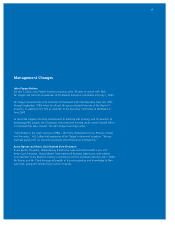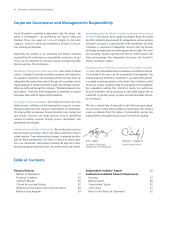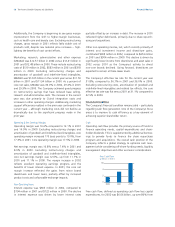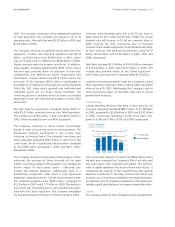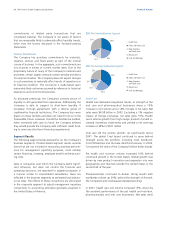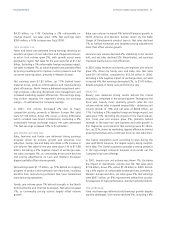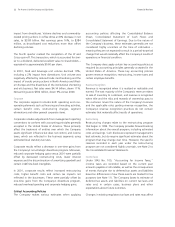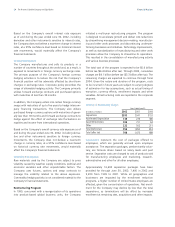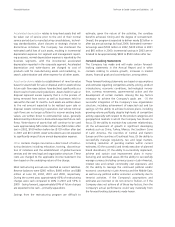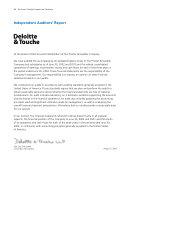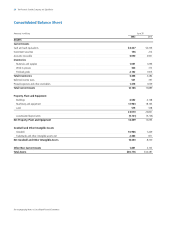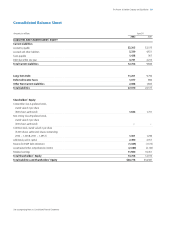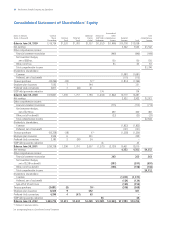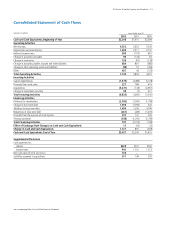Proctor and Gamble 2002 Annual Report Download - page 24
Download and view the complete annual report
Please find page 24 of the 2002 Proctor and Gamble annual report below. You can navigate through the pages in the report by either clicking on the pages listed below, or by using the keyword search tool below to find specific information within the annual report.impact from divestitures. Volume declines and commodity-
related pricing actions in coffee drove an 8% decrease in net
sales, to $3.80 billion. Net earnings grew 16%, to $384
million, as broad-based cost reductions more than offset
declining volumes.
The fourth quarter marked the completion of the Jif and
Crisco spin-off. This transaction, which is accounted for simi-
lar to a dividend, delivered excellent value to shareholders –
equivalent to approximately $0.60 per share.
In 2001, food and beverage unit volume declined 10%,
including a 2% impact from divestitures. Unit volume was
negatively affected by reduced trade merchandising and the
impact of snacks pricing actions in North America and West-
ern Europe and the divestiture of the institutional shortening
and oils business. Net sales were $4.14 billion, down 11%.
Net earnings were $332 million, down 9% versus 2000.
Corporate
The corporate segment includes both operating and non-
operating elements such as financing and investing activities,
certain benefit costs, restructuring charges, segment
eliminations and other general corporate items.
Corporate includes adjustments from management reporting
conventions to conform with accounting principles generally
accepted in the United States of America. These primarily
affect the treatment of entities over which the Company
exerts significant influence but does not control, and income
taxes, which are reflected in the business segments using
estimated local statutory tax rates.
Corporate results reflect a decrease in one-time gains from
the Company’s non-strategic divestiture program. Moreover,
reduced corporate hedging gains versus 2001 were partially
offset by decreased restructuring costs, lower interest
expense and the discontinuation of amortizing goodwill and
certain indefinite-lived intangibles.
In 2001, corporate results reflect increased restructuring
costs, higher benefit costs and certain tax impacts not
reflected in the businesses. These were partially offset by
one-time gains from the Company’s divestiture program,
reduced overhead spending and corporate hedging gains.
Critical Accounting Policies
The Company makes various estimates when applying
accounting policies affecting the Consolidated Balance
Sheet, Consolidated Statement of Cash Flows and
Consolidated Statement of Earnings. Due to the nature of
the Company’s business, these estimates generally are not
considered highly uncertain at the time of estimation –
meaning they are not expected to result in a period-to-period
change that would materially affect the Company’s results of
operations or financial condition.
The Company does apply certain key accounting policies as
required by accounting principles generally accepted in the
United States of America. These key accounting policies
govern revenue recognition, restructuring, income taxes and
certain employee benefits.
Revenue Recognition
Revenue is recognized when it is realized or realizable and
earned. The vast majority of the Company’s revenue relates
to sale of inventory to customers, and revenue is recognized
when title and the risks and rewards of ownership pass to
the customer. Given the nature of the Company’s business
and the applicable rules guiding revenue recognition, the
Company’s revenue recognition practices do not contain
estimates that materially affect results of operations.
Restructuring
Restructuring charges relate to the restructuring program
that began in 1999. The Company provides forward-looking
information about the overall program, including estimated
costs and savings. Such disclosures represent management’s
best estimate, but do require significant estimates about the
program that may change over time. However, the specific
reserves recorded in each year under the restructuring
program are not considered highly uncertain, see Note 2 to
the Consolidated Financial Statements.
Income Taxes
Under SFAS No. 109, ”Accounting for Income Taxes,”
income taxes are recorded based on the current year
amounts payable or refundable, as well as the consequences
of events that give rise to deferred tax assets and liabilities
based on differences in how those events are treated for tax
purposes (see Note 11). The Company bases its estimate of
deferred tax assets and liabilities on current tax laws and
rates and, in certain cases, business plans and other
expectations about future outcomes.
Changes in existing regulatory tax laws and rates may affect
Financial Review22 The Procter & Gamble Company and Subsidiaries





